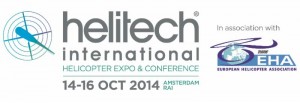 ‘Although helicopter flights are relatively safe, dozens of accidents involving helicopters do occur in Europe every year, including some that result in fatalities. The European Helicopter Safety Team (EHEST) has commissioned a technology team led by the National Aerospace Laboratory of the Netherlands (NLR) to survey both existing technologies and promising new technologies that can be used to make helicopter flights even safer. The results of this study will be presented at the Helitech Safety Workshop, which will be held on 16 October in Amsterdam.
‘Although helicopter flights are relatively safe, dozens of accidents involving helicopters do occur in Europe every year, including some that result in fatalities. The European Helicopter Safety Team (EHEST) has commissioned a technology team led by the National Aerospace Laboratory of the Netherlands (NLR) to survey both existing technologies and promising new technologies that can be used to make helicopter flights even safer. The results of this study will be presented at the Helitech Safety Workshop, which will be held on 16 October in Amsterdam.
The main question addressed by the study was: Which existing and new technologies can contribute to the prevention of which type of accident? For instance, excessive impact during landing is a cause of helicopter accidents. So how can you ensure that the cockpit instrument that measures the distance to the ground does not fail, and that the information displayed by the instrument is interpreted correctly and in a timely manner by the pilot? To answer questions such as these, a dedicated EHEST team analyzed a large number of helicopter accidents, and used the results to compile a ‘top 20’ of the most common safety issues. The technology team then compiled a ‘technology matrix’ that indicates which technological solutions are most effective in preventing each safety issue. The availability and relative cost of such technologies was also taken into consideration.
Helicopter manufacturers can use the technology matrix to make their aircraft even safer. The tool is also intended to be used by regulators and government authorities to establish preconditions for the safer use of helicopters. The matrix also encourages R&D organizations and universities to design new technologies or improve existing ones, in close consultation with manufacturers and regulators.



